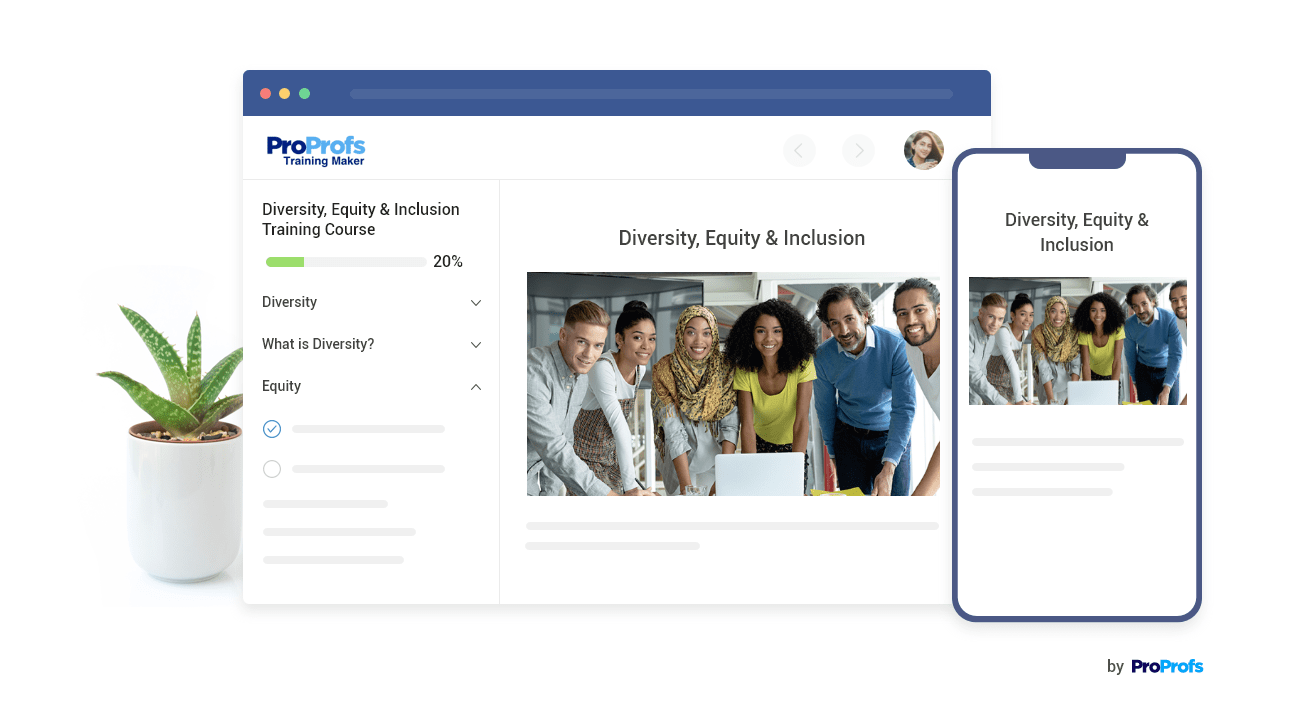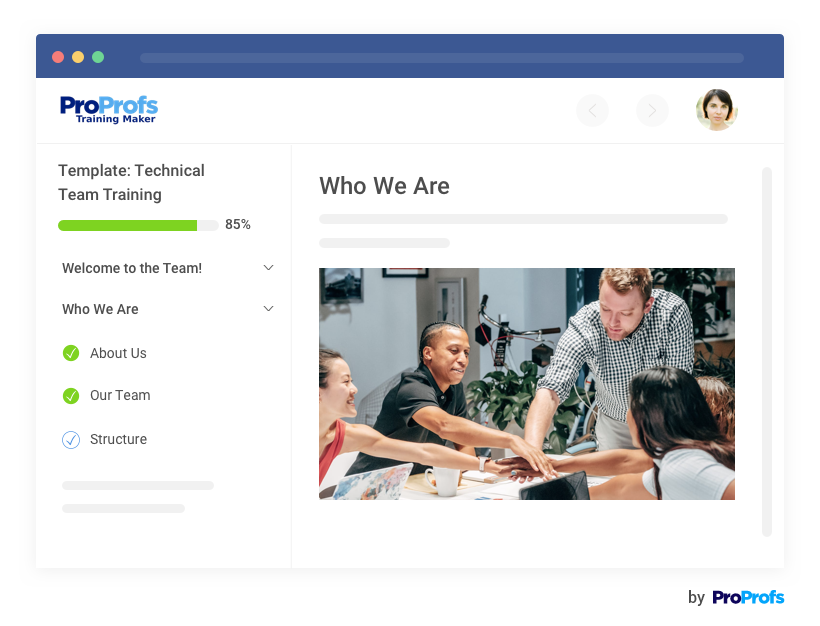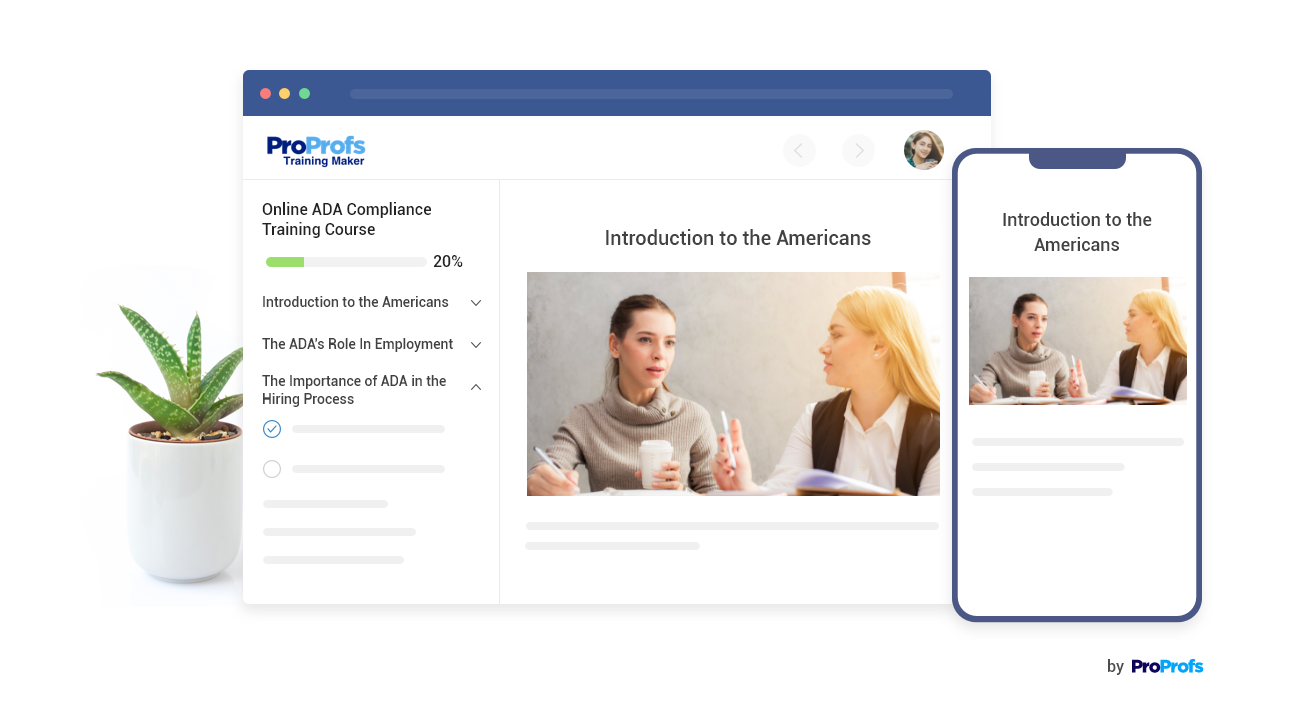Managers and leaders across organizations face a top responsibility: creating an environment where everyone feels valued, respected, and empowered to contribute their best.
Yet, the reality is that discrimination still exists in many workplaces, manifesting in subtle and overt ways and hindering employees’ potential for success.
But we don’t have to accept this. Discrimination training can go a long way in building a more equitable organization.
In this blog post, I will cover everything you need to know about such training, including how to prevent workplace discrimination and the courses you can administer.
What Is Discrimination Training?
Discrimination training is an educational program that raises awareness and understanding of discrimination in the workplace, its types, and how to prevent and address it.
Discrimination training requires commitment and support from all stakeholders, such as trainers, trainees, managers, leaders, and policymakers.
Discrimination training may cover topics such as:
- What constitutes discrimination based on race, color, religion, sex, national origin, disability, age, or genetic information.
- How to prevent, report, and resolve discrimination issues.
- The rights and responsibilities of employees and employers under federal, state, and local anti-discrimination laws.
- The consequences of violating anti-discrimination laws and policies.
9 Types of Discrimination Training
Discrimination training comes in many forms, each designed to tackle different aspects of bias and prejudice.
I am giving a quick overview of some common discrimination training types:
- Diversity and Inclusion Training
- Sexual Harassment Training
- Anti-Discrimination Policies and Procedures
- Disability Awareness Training
- Cultural Sensitivity Training
- ABA-Based Discrimination Training
- Age Discrimination Training
- LGBTQ + Inclusion Training
- Implicit Bias Training
Let’s now explore each type in detail:
1. Diversity and Inclusion Training

This training covers unconscious bias, cultural competence, and the benefits of a diverse workforce. Participants learn about different perspectives, backgrounds, and experiences to enhance their understanding of diversity. Read more on DEI training.
2. Sexual Harassment Prevention Training
POSH training focuses on educating employees about what constitutes sexual harassment, how to identify it, and the steps to take if they experience or witness such behavior.
This discrimination training for employees guides participants on how to create a respectful and healthy workplace culture.
3. Anti-Discrimination Policies and Procedures
These training programs familiarize employees with company policies related to discrimination and harassment. This includes information on how to report incidents and the consequences of engaging in discriminatory behavior.
4. Disability Awareness Training

Another example of discrimination training is disability awareness training. Such training aims to increase understanding of disabilities, accommodations, and the importance of inclusivity for employees with disabilities. It also offers guidance on creating an accessible and supportive workplace environment.
5. Cultural Sensitivity Training

This training addresses stereotypes, prejudices, and cultural insensitivity. It encourages employees to appreciate and respect diverse cultures, promoting an inclusive atmosphere.
6. ABA-Based Discrimination Training

Applied Behavior Analysis (ABA) is a scientific approach to understanding human behavior. It’s used in a variety of contexts to improve socially significant behaviors.
Discrimination training in ABA involves identifying behavioral objectives, observing and recording behaviors, and providing interventions that reinforce desired behaviors or reduce undesired ones.
This evidence-based approach breaks down skill acquisition into four digestible steps: clear instructions, modeling, practice opportunities, and targeted feedback. It’s a gold standard for training staff and non-ABA professionals in ABA interventions. Its impact on performance solidifies ABA training as a versatile and adaptable training champion.
7. Age Discrimination Training
It focuses on dispelling stereotypes related to age and promoting a workplace that values employees of all age groups. Plus, this workplace discrimination training educates on the legal aspects of age discrimination and how to avoid biased behavior. The goal of this training is to help build an age-diverse workplace.
8. LGBTQ+ Inclusion Training

With such training, you can create an inclusive environment for employees regardless of their sexual orientation or gender identity. LGBTQ training addresses stereotypes, provides information on LGBTQ+ issues, and promotes understanding and acceptance.
9. Implicit Bias Training
Explore unconscious biases that may affect decision-making and interactions in the workplace through this training. Implicit bias training provides strategies to recognize and mitigate implicit prejudice or implicit attitudes and foster fair and equitable treatment.
Impact of Discrimination on the Workplace
The impact of discrimination in the workplace can be far-reaching and damaging.
Here’s a closer look at some of the key consequences:
- High Turnover
Research by the Society for Human Resource Management (SHRM) found that employee turnover due to racial inequity has cost American organizations up to $172 billion over the past five years.
Employees who are discriminated against are more likely to leave their jobs. This can lead to increased costs of recruiting and training new employees.
- Legal Liability
In 2022, there were 73,485 workplace discrimination charges in the US, which resulted in more than $39 million in damages for victims in federal court.
So, as you can see, organizations that engage in discrimination can be sued by employees. This can lead to significant financial costs and damage to the organization’s reputation.
- Damaged Reputation
Organizations that are known for discrimination can damage their reputation and make it difficult to attract and retain top talent.
- Reduced Job Satisfaction and Engagement
Employees who are discriminated against are less likely to be happy and engaged in their work. They may feel undervalued, unappreciated, and isolated.
The American Psychological Association’s 2021 Work and Well-being Survey found that employees who have experienced or witnessed discrimination in their current workplace are more than twice as likely as those who haven’t to say they intend to seek employment outside of their company or organization in the next year (68% vs. 33%). This suggests that these employees are not happy or engaged at work.
- Lower Productivity and Performance
Discrimination can create a hostile work environment that makes it difficult for employees to focus and be productive. It can also lead to absenteeism and presenteeism (being physically present but not mentally engaged).
Here are some specific examples of how workplace discrimination training can manifest:
- Promotion Denial: Despite equal qualifications, a minority employee is passed over for a promotion while a less qualified colleague of the majority group is chosen.
- Leadership Bias: Women are consistently overlooked for leadership positions due to unconscious assumptions about their capabilities.
- Microaggressions: Employees of color are subjected to repeated subtle slights and offensive jokes related to their race or ethnicity.
- Unequal Pay: Female employees receive lower salaries than their male counterparts for performing the same job duties.
- Religious Partiality: Company policies readily accommodate holidays of dominant religions but lack provisions for minority faiths.
These are just a few examples, but discrimination can manifest in countless ways across various aspects of the workplace. It’s crucial to be aware of these subtle and overt forms to foster a more equitable and inclusive work environment.
How to Prevent Discrimination in the Workplace
If you want to create a work environment that is free from discrimination, there needs to be a multi-faceted approach aimed at both prevention and proactive steps. Here are some key strategies:
- Strong policies and procedures: Develop clear and comprehensive anti-discrimination policies that outline prohibited behaviors and how complaints will be handled. Regularly review and update these policies to ensure they reflect current best practices and legal requirements.
Try out this Employee & Office Policies template:

- Training and Education: Invest in diversity and inclusion training for all employees, including managers and supervisors. Train your employees to recognize and identify discriminatory behavior, understand unconscious bias, and build inclusive workplaces.
- Fair Hiring and Promotion Practices: Implement objective and standardized hiring and promotion processes based on merit and qualifications. Encourage candidates to build comprehensive and well-structured resumes that highlight their skills and achievements. Use blind resume reviews, diverse interview panels, and clear job descriptions to mitigate bias.
- Culture of Belonging: Foster a culture that values and respects the diverse backgrounds, perspectives, and experiences of all employees. Encourage open communication, celebrate differences, and address microaggressions promptly.
- Reporting and Accountability
Encourage employees to report instances of discrimination without fear of retaliation. Because retaliation is the most common discrimination claim, accounting for 56% of all claims.
Ensure a confidential and responsive complaint process is in place, and hold individuals accountable for discriminatory behavior.
- Diversity and Inclusion Initiatives
Go beyond simply complying with anti-discrimination laws by actively promoting diversity and inclusion through employee resource groups, mentorship programs, and opportunities for professional development for underrepresented groups.
I feel discrimination training should be a combined effort and commitment from both employers and employees.
I’ll share one case study as well.
Microsoft wanted to stop unfair treatment at work, so they created special training.
At first, they just wanted employees to know about biases, like quick judgments based on things like race or gender. But then, they realized it wasn’t enough. Just knowing about biases might not help. So, they changed the training to teach employees how to control these biases, learn new habits, and see their progress over time.
This training wasn’t a one-time thing. It was a longer journey with changes in how the company works. It shared stories that went against stereotypes and let employees connect with others who had different experiences.
This case teaches us that stopping unfair treatment needs everyone’s effort. Companies must provide timely help and create a good learning environment. And at the same time, employees should join in, use what they learn every day, and check their own progress.
Get Free Employee Training Software — All Features, Forever.
We've helped 567 companies train 200,000+ employees. Create courses in under a minute with our AI LMS or use 200+ ready-made courses on compliance, harassment, DEI, onboarding, and more!
8 Best Online Discrimination Training Courses
Here are the top discrimination training courses and programs that you can incorporate into your workplace training
1. Federal Sexual Harassment Training
This is the first course on discrimination training that I’d recommend. The “Online Sexual Harassment Prevention Training” is a comprehensive course to educate employees and ensure compliance with federal and state regulations.
Mandated by laws such as the Fair Employment and Housing Act and Title VII, this harassment and discrimination training covers various aspects, including types of sexual harassment, retaliation, and the responsibility of supervisory personnel.
This course by ProProfs Training Maker contains real-life scenarios, interactive quizzes, and worksheets. It meets federal and state requirements and provides auto-generated reports, anytime, anywhere learning, and 24/7 support.
2. Diversity, Equity, and Inclusion
I recommend considering this Diversity, Equity & Inclusion (DEI) training as a part of your discrimination training program because it goes beyond simply identifying specific biases and discrimination.
This discrimination training for employees delves into the interconnected concepts of diversity, equity, and inclusion, equipping employees with tools to build a truly welcoming and respectful workplace for all.
It tackles the systemic roots of discrimination and unconscious bias, providing strategies to overcome these barriers and foster a sense of belonging for everyone.
While traditional discrimination training focuses on legal aspects and avoiding discriminatory practices, this DEI training actively creates an environment where discrimination is less likely to occur in the first place.
3. Bystander Intervention
I highly recommend adding the ProProfs Bystander Intervention Training to your existing discrimination training program. It’s like adding a powerful active defense to your existing passive shield.
This course tackles the “bystander effect” head-on, equipping your team with practical skills to intervene in diverse forms of discrimination, from racism and sexism to ageism and bias. Real-life scenarios bring the training to life while building on the foundation of your existing DEI program.
This proactive approach can build a culture of intervention and respect, sending a clear message that discrimination has no place in your workplace.
4. ADA Compliance Training

Disabled workers have historically faced high levels of discrimination in the workplace, as evidenced by the 24,238 disability discrimination claims resolved by the U.S. Equal Employment Opportunity Commission in 2019.
To truly build an inclusive workplace, consider pairing your existing discrimination training with ProProfs Training Maker’s comprehensive ADA Compliance Training.
This discrimination training program goes beyond general anti-discrimination principles to specifically equip HR and management teams with the knowledge and skills to create a disabled-friendly hiring process.
It delves into the complexities of the ADA, addressing permissible questions, protected entities, and potential legal pitfalls. By empowering your team to navigate disability inclusion in recruitment confidently, you’ll not only meet compliance requirements but also actively cultivate a more equitable and welcoming environment for all.
5. Workplace Ethics Training
Ethical decision-making is another crucial piece of a truly exemplary workplace. This course empowers employees to navigate complex ethical dilemmas and uphold high ethical standards in their daily work.
Led by James Galluzzo, a seasoned HR consultant with over 25 years of experience, this course is a comprehensive exploration of business ethics, focusing on individual and collective responsibilities, legal guidelines, and ethical frameworks.
Gain insights into fostering a culture of integrity, diversity, equity, and inclusion while addressing conflicts of interest and corruption incidents. Ideal for new leaders and supervisors, this course equips participants with the knowledge to build and sustain an ethical workplace.
6. Workplace Violence Prevention Training
This is another course you should consider as an integral part of your discrimination training program. Discrimination can contribute to a toxic atmosphere and create tension, frustration, and resentment among employees. In some cases, this hostile environment may escalate into violence.
Led by the experienced HR consultant James Galluzzo, this course offers a comprehensive exploration of business ethics, emphasizing individual and collective responsibilities, legal guidelines, and ethical frameworks.
This online anti-discrimination training can help employees gain valuable insights into fostering a culture of integrity, diversity, equity, and inclusion while addressing conflicts of interest and corruption incidents. The course covers prevention strategies, risk factors evaluation, and incident response planning.
Given James’ extensive background in human resources and leadership development, this training is particularly relevant for teams to build and sustain an ethical workplace.
7. Conflict Resolution
Unresolved conflicts in the workplace can detrimentally impact professional relationships, productivity, and business reputation.
Over 65% of performance problems result from strained relationships between employees, not from incompetence.
Discrimination often manifests through conflicts, and addressing these issues promptly is essential to prevent escalation.
Conflict resolution training equips participants with effective communication strategies. This enables them to resolve conflicts before they negatively impact professional relationships or contribute to discrimination-related issues.
By understanding the four main communication methods and knowing when to seek third-party intervention, employees and leaders can proactively address conflicts and create a more inclusive work environment. Integrating conflict resolution skills into discrimination training emphasizes an organization’s commitment to maintaining a respectful and fair workplace where conflicts are handled promptly and impartially.
8. How to Create a Positive Work Environment
Discrimination often thrives in negative work environments, and this course aims to create a culture that opposes such tendencies. Participants will gain insights into identifying the characteristics of a positive work environment, promoting communication, collaboration, and positivity.
Through this online discrimination training course, employees and leaders can contribute to a workplace culture that actively discourages discrimination.
Expressing gratitude, being consistent, and encouraging positivity and collaboration are essential components of building an environment where everyone feels valued and respected.
Ready to Implement Discrimination Training?
Discrimination has no place in the modern workplace. It stifles creativity, hinders productivity, and erodes trust. But the power to change lies within us. By committing to discrimination training, you can foster a culture of inclusivity and equip your teams with the tools to recognize and address bias.
Let’s not simply accept the reality of discrimination. Let’s actively create a future where every individual feels valued, respected, and empowered to contribute their full potential.
This is not just a legal obligation, it’s a moral imperative. It’s time to choose inclusion, progress, and a better future for ourselves, our organizations, and communities.
 Tips
Tips
We’d love to hear your tips & suggestions on this article!
Get Free Employee Training Software — All Features, Forever.
We've helped 567 companies train 200,000+ employees. Create courses in under a minute with our AI LMS or use 200+ ready-made courses on compliance, harassment, DEI, onboarding, and more!

 We'd love your feedback!
We'd love your feedback! Thanks for your feedback!
Thanks for your feedback!







